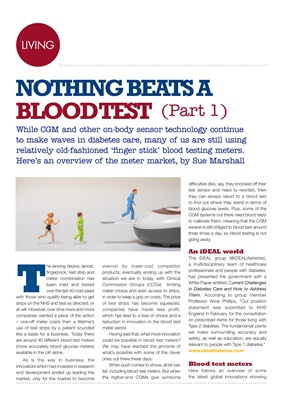
LIVINGLIVING
NOTHING BEATS A
BLOOD TEST
While CGM and other on-body sensor technology continue
to make waves in diabetes care, many of us are still using
relatively old-fashioned 'finger stick' blood testing meters.
Here's an overview of the meter market, by Sue Marshall
T
he lancing device, lancet,
fingerprick, test strip and
meter combination has
been tried and tested
over the last 40-odd
years with those who qualify being able to
get strips on the NHS and test as directed,
or at will. However, over time more and
more companies wanted a piece of the
action - with one-off meter costs then a
lifetime's use of test strips by a patient
sounded like a basis for a business. Today
there are around 40 different blood test
meters (more accurately blood glucose
meters) available in the UK alone.
As is the way in business, the
innovators which had invested in research
and development ended up leading the
market, only for the market to become
over run by lower-cost competitor
products, eventually for us to end up with
the situation we are in today with CCGs
limiting meter choice and access to strips
in order to keep a grip on costs. Cost of
test strips have become squeezed, which
has lead in the end to a loss of choice and
a reduction in innovation in the blood test
meter sector.
Having said that, what more innovation
could be possible in blood test meters?
We may have reached the pinnacle of
what's possible with some of the clever
ones out there these days.
When push comes to shove, all kit can
fail, including blood test meters. But when
the higher-end CGMs give someone
difficulties (like, say, they knocked off their
last sensor and need to reorder), then
they can always resort to a blood test
to find out where they stand in terms of
blood glucose levels. Plus, some of the
CGM systems out there need blood tests
to calibrate them, meaning that the CGM
wearer is still obliged to blood test around
three times a day.
The accuracy factor
Blood test meters must conform to ISO
standards, but some conform better than
others. Inaccuracy could lead to dosing
and other treatment errors and can cause
hypos, some of which might even be
severe. For further info, see How accurate
is my blood test meter, a report by INPUT.
inputdiabetes/how-accurate?
An iDEAL world
The iDEAL group (@iDEALdiabetes),
a multidisciplinary team of healthcare
professionals and people with diabetes,
has presented the government with
a White Paper: Current Challenges in
Diabetes Care and How to Address Them.
According to group member Professor
Anne Phillips (who has diabetes), "Our
position statement was submitted to NHS
England in February for the consultation
on prescribed items for those living with
(Part 1)